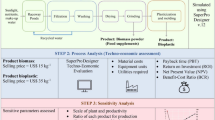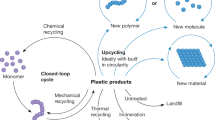Abstract
The unprecedented accumulation of plastic waste forms a serious threat to the biosphere, and current recycling efforts are not living up to their promise. Replacements for synthetic plastics are therefore critically needed, which has led to a rapid growth in research surrounding the development of sustainable materials, such as bioproducts. Still, commercialization has been limited, as knowledge gaps separating publicly funded research from industrial implementation need to be overcome. The food-packaging sector is currently undergoing drastic transformations in phasing out plastics and can therefore provide a blueprint for catalysing the adoption of bioproducts that could be applicable to other sectors.
This is a preview of subscription content, access via your institution
Access options
Access Nature and 54 other Nature Portfolio journals
Get Nature+, our best-value online-access subscription
$29.99 / 30 days
cancel any time
Subscribe to this journal
Receive 12 digital issues and online access to articles
$119.00 per year
only $9.92 per issue
Buy this article
- Purchase on Springer Link
- Instant access to full article PDF
Prices may be subject to local taxes which are calculated during checkout


Similar content being viewed by others
References
Geyer, R., Jambeck, J. R. & Law, K. L. Production, use, and fate of all plastics ever made. Sci. Adv. 3, e1700782 (2017).
de Souza Machado, A. A., Kloas, W., Zarfl, C., Hempel, S. & Rillig, M. C. Microplastics as an emerging threat to terrestrial ecosystems. Glob. Change Biol. 24, 1405–1416 (2018).
Cole, M., Lindeque, P., Halsband, C. & Galloway, T. S. Microplastics as contaminants in the marine environment: a review. Mar. Pollut. Bull. 62, 2588–2597 (2011).
Zhang, J., Wang, L., Trasande, L. & Kannan, K. Occurrence of polyethylene terephthalate and polycarbonate microplastics in infant and adult feces. Environ. Sci. Technol. Lett. 8, 989–994 (2021).
Li, T. et al. Developing fibrillated cellulose as a sustainable technological material. Nature 590, 47–56 (2021).
Ates, B., Koytepe, S., Ulu, A., Gurses, C. & Thakur, V. K. Chemistry, structures, and advanced applications of nanocomposites from biorenewable resources. Chem. Rev. 120, 9304–9362 (2020).
Virtanen, S., Chowreddy, R. R., Irmak, S., Honkapää, K. & Isom, L. Food industry co-streams: potential raw materials for biodegradable mulch film applications. J. Polym. Environ. 25, 1110–1130 (2017).
Circular Economy Action Plan (European Commission, 2020); https://doi.org/10.2775/855540
Stahel, W. R. The circular economy. Nature 531, 435–438 (2016).
Pauliuk, S. Making sustainability science a cumulative effort. Nat. Sustain. 3, 2–4 (2020).
Moradali, M. F. & Rehm, B. H. A. Bacterial biopolymers: from pathogenesis to advanced materials. Nat. Rev. Microbiol. 18, 195–210 (2020).
Kaur, L., Khajuria, R., Parihar, L. & Singh, G. D. Polyhydroxyalkanoates: biosynthesis to commercial production—a review. J. Microbiol. Biotechnol. Food Sci. 6, 1098–1106 (2017).
Jabeen, N., Majid, I. & Nayik, G. A. Bioplastics and food packaging: a review. Cogent Food Agric. 1, 1117749 (2015).
Yan, N. & Chen, X. Sustainability: don’t waste seafood waste. Nature 524, 155–157 (2015).
Domard, A. A perspective on 30 years research on chitin and chitosan. Carbohydr. Polym. 84, 696–703 (2011).
Tardy, B. L. et al. Deconstruction and reassembly of renewable polymers and biocolloids into next generation structured materials. Chem. Rev. 121, 14088–14188 (2021).
Sachs, J. D. et al. Six transformations to achieve the Sustainable Development Goals. Nat. Sustain. 2, 805–814 (2019).
Jones, M., Gandia, A., John, S. & Bismarck, A. Leather-like material biofabrication using fungi. Nat. Sustain. 4, 9–16 (2020).
Zhao, X., Cornish, K. & Vodovotz, Y. Narrowing the gap for bioplastic use in food packaging: an update. Environ. Sci. Technol. 54, 4712–4732 (2020).
Camberato, J. J., Gagnon, B., Angers, D. A., Chantigny, M. H. & Pan, W. L. Pulp and paper mill by-products as soil amendments and plant nutrient sources. Can. J. Soil Sci. 86, 641–653 (2006).
Faria, M. et al. Minimum information reporting in bio–nano experimental literature. Nat. Nanotechnol. 13, 777–785 (2018).
Schultz, D. & Campeau, L. C. Harder, better, faster. Nat. Chem. 12, 661–664 (2020).
Debecker, D. P. et al. Shaping effective practices for incorporating sustainability assessment in manuscripts submitted to ACS Sustainable Chemistry & Engineering: catalysis and catalytic processes. ACS Sustain. Chem. Eng. 9, 4936–4940 (2021).
Xia, Q. et al. A strong, biodegradable and recyclable lignocellulosic bioplastic. Nat. Sustain. 4, 627–635 (2021).
Vollmer, I. et al. Beyond mechanical recycling: giving new life to plastic waste. Angew. Chem. Int. Ed. 59, 15402–15423 (2020).
RameshKumar, S., Shaiju, P., O’Connor, K. E. & P, R. B. Bio-based and biodegradable polymers—state-of-the-art, challenges and emerging trends. Curr. Opin. Green Sustain. Chem. 21, 75–81 (2020).
Villanueva, A. & Wenzel, H. Paper waste—recycling, incineration or landfilling? A review of existing life cycle assessments. Waste Manage. 27, S29–S46 (2007).
Melo, F. P. L. et al. Adding forests to the water–energy–food nexus. Nat. Sustain. 4, 85–92 (2021).
Wyser, Y. & Shires, D. Increasing the quality and impact of manuscripts in the field of new materials. Packag. Technol. Sci. 32, 3–5 (2019).
Kinnunen, P. et al. Local food crop production can fulfil demand for less than one-third of the population. Nat. Food 1, 229–237 (2020).
Verghese, K., Lewis, H., Lockrey, S. & Williams, H. Packaging’s role in minimizing food loss and waste across the supply chain. Packag. Technol. Sci. 28, 603–620 (2015).
Wang, J. et al. Moisture and oxygen barrier properties of cellulose nanomaterial-based films. ACS Sustain. Chem. Eng. 6, 49–70 (2018).
Tardy, B. L. et al. Exploiting supramolecular interactions from polymeric colloids for strong anisotropic adhesion between solid surfaces. Adv. Mater. 32, 1906886 (2020).
Sev, A. How can the construction industry contribute to sustainable development? A conceptual framework. Sustain. Dev. 17, 161–173 (2009).
Agarwal, J., Sahoo, S., Mohanty, S. & Nayak, S. K. Progress of novel techniques for lightweight automobile applications through innovative eco-friendly composite materials: a review. J. Thermoplast. Compos. Mater. 33, 978–1013 (2020).
Jabbour, L., Bongiovanni, R., Chaussy, D., Gerbaldi, C. & Beneventi, D. Cellulose-based Li-ion batteries: a review. Cellulose 20, 1523–1545 (2013).
Agate, S., Joyce, M., Lucia, L. & Pal, L. Cellulose and nanocellulose-based flexible-hybrid printed electronics and conductive composites—a review. Carbohydr. Polym. 198, 249–260 (2018).
Blankenship, R. E. et al. Comparing photosynthetic and photovoltaic efficiencies and recognizing the potential for improvement. Science 332, 805–809 (2011).
Ioannidis, J., Kim, B. & Trounson, A. How to design preclinical studies in nanomedicine and cell therapy to maximize the prospects of clinical translation. Nat. Biomed. Eng. 2, 797–809 (2018).
Sumner, L. W. et al. Proposed minimum reporting standards for chemical analysis: Chemical Analysis Working Group (CAWG) Metabolomics Standards Initiative (MSI). Metabolomics 3, 211–221 (2007).
Yam, K. The Wiley Encyclopedia of Packaging Technology (John Wiley & Sons, 2010).
Acknowledgements
This work received funding from the European Research Council under the European Union’s Horizon 2020 research and innovation programme (grant agreement no. 788489, ‘BioElCell’). J.J.R. is the recipient of an Australian Research Council Future Fellowship (project no. FT210100669) funded by the Australian government and JSPS Fellowship P20373 from the Japanese Society for the Promotion of Science. B.L.T. is the recipient of the Khalifa University of Science and Technology (KUST) Faculty Startup Project (Project: FSU-2022-021).
Author information
Authors and Affiliations
Contributions
B.L.T., L.G.G., J.J.R. and J.B. contributed to the conceptualization, investigation and writing of the original draft. J.G. and O.J.R. discussed and edited the manuscript.
Corresponding author
Ethics declarations
Competing interests
The authors declare no competing interests.
Peer review
Peer review information
Nature Sustainability thanks Ramesh P. Babu, Run-Cang Sun and Yael Vodovotz for their contribution to the peer review of this work.
Additional information
Publisher’s note Springer Nature remains neutral with regard to jurisdictional claims in published maps and institutional affiliations.
Supplementary information
Supplementary Information
Supplementary Tables 1–3, Fig. 1 and Discussions 1–6.
Rights and permissions
Springer Nature or its licensor (e.g. a society or other partner) holds exclusive rights to this article under a publishing agreement with the author(s) or other rightsholder(s); author self-archiving of the accepted manuscript version of this article is solely governed by the terms of such publishing agreement and applicable law.
About this article
Cite this article
Tardy, B.L., Richardson, J.J., Greca, L.G. et al. Advancing bio-based materials for sustainable solutions to food packaging. Nat Sustain 6, 360–367 (2023). https://doi.org/10.1038/s41893-022-01012-5
Received:
Accepted:
Published:
Issue Date:
DOI: https://doi.org/10.1038/s41893-022-01012-5
This article is cited by
-
Scalable production of carboxylated cellulose nanofibres using a green and recyclable solvent
Nature Sustainability (2024)
-
Development and characterization of biodegradable bilayer packaging films based on corn starch-polylactic acid as raw material
Journal of Food Measurement and Characterization (2024)
-
Cellulosic surfaces endowed with chemical reactivity by physical adsorption of functionalized polysaccharides
Cellulose (2023)




